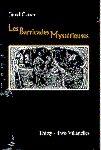Plagiarist.com Articles
Jared Carter's Les Barricades Mystérieuses
Les Barricades Mystérieuses
by Jared Carter
48 pages | PB $10.00 | Cleveland State University Poetry Center | 1999
ISBN: 1880834405 | Order from Amazon.com
Poets writing in form today are usually seen either as quaint throwbacks to a bygone era, or (in the case of the "New Formalist" school), pedantic hacks making a mad argument with the rest of the world: "This is worth reading because it is written in form, which is hard to do." Take away the form, and most of these so-called "expansive" poems crumble.
Jared Carter's ambitious Les Barricades Mystérieuses is a collection of 32 villanelles (see the sidebar for a brief primer on the villanelle form) that falls into neither of these camps. The poems are written in a strict verse form, but aren't making a case for the form. There is no polemic, no pedantic adhesion to form for its own sake. In Carter's collection, form truly follows function. The villanelle form serves the poems. In a lesser poet's hands, the poems would be shoe-horned into the form.
To write and publish a book consisting entirely of villanelles can not be seen as anything less than ballsy. It's a bold idea, because the repetition of a form which itself employs repetition risks growing quickly tiresome. Carter's 32 poems seem to be about the right amount. The book is short enough to read in a single sitting but long enough to allow the flow of the poems to accrue.
While the poems do not make up a narrative per se, there is more uniting the collection than merely its form. The book is broken up into four sections each containing eight poems. Each poem has a single-word title. Due to the exigencies of the villanelle, the poems are all the same length.
Carter varies the refrains (repeated lines) in some of the poems. For instance, in "Summons," the third line's punctuation is altered each time it is repeated:
Line 3: The dog's asleep. On the hearth near the fire, Line 9: The dog's asleep. On the hearth, near the fire, Line 15: The dog's asleep on the hearth, near the fire; Line 19: the dog's asleep on the hearth near the fire.
Each small change helps to vary not only the look of the line, but alters the meter and phrasing as well. Some of the poems are written in meter (usually iambic pentameter) but the meter in those poems isn't comic or metronomic.
I always pay special attention to the first lines of villanelles because I know those phrases will be repeated throughout the poem. A poem beginning with "Now they are calling—these ambient grasses" tends to make me sink a little into my chair, as some cumbersome lines are best left unrepeated, like the first line of "Portage" which begins "Vestigial signs remain. Marks in the rock—". Yowza. It's to Carter's credit that his repetitions are usually clever, and that the remainder of the repetitions are far less of a mouthful.
It's easy to focus on the form and technique in a book of poems - but what of the poems themselves? Les Barricades Mystérieuses is filled with beautiful images which resonate through their repetition and reflect like an echo.
Take, for example, the first two lines of "Loess":
So far above us now, mimosa lifting, reaching out to the rain's sporadic touch—
The images which emerge from Les Barricades Mystérieuses are nearly afterimages - they're images of something vanishing, disappearing, retreating or receding. Candles are blown out, darkness covers the snow, minnows disappear, narrow scaffolding gathers shadows, and we are returned poem after poem to dimming light, or a furrow of shade. The poems exist in a world where "no one ever sees anything, no one knows."
The "oh" sound is so prevalent throughout the collection that the poems, when spoken aloud, sound like a deep exhale; of contentment, regret, or resignation.
The beauty of an entire volume of villanelles is that eventually the form begins to dissipate, and the poems themselves emerge. The result is hypnotic. I can understand why the villanelle, although a difficult form in which to write a poem, would be the perfect form to obsess over. A good villanelle is difficult enough to write, and 32 of them in a single book is an impressive display of stamina. In a lesser poet's hands, just the sheer number of villanelles would be technically impressive. But written by Jared Carter, Les Barricades Mystérieuses is a tour de force, more impressive for its skillfully written poems than its technical merits.
You can read a selection of poems from Les Barricades Mystérieuses, as well as from Jared Carter's other works, in the poetry archive.
![[home]](http://plagiarist.com/images/home.gif)
